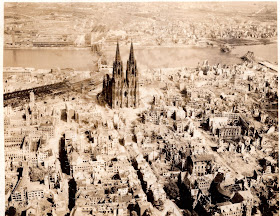 |
| Agrippina-Nero's Mother |
Most people think of the famous cathedral when they think of Cologne, but it is a much more ancient city. The first urban settlement on the grounds of what today is the centre of Cologne was Oppidum Ubiorum, which was founded in 38 BC by the Ubii, a Germanic tribe. In 50 A.D. the Romans founded Colonia on the Rhine and the city became the provincial capital of Germania Inferior in 85 A.D. The city was named "Colonia Claudia Ara Agrippinensium" in 50 A.D. because Agrippina was born there.
 |
| Rudder of Roman boat |
Considerable Roman remains can be found in present-day Cologne, especially near the wharf area, where a notable discovery of a 1900 year old Roman boat was made in late 2007. In Carried Away, the hero, Dieter von Wolfenberg, takes his heroine on a tour of the Roman ruins in an effort to win her over.
From 260 A.D. to 271 A.D., Cologne was the capital of the Gallic Empire. In 310 A.D., under Constantine, a bridge was built over the Rhine at Cologne. The imperial governors of Rome resided in the city and it became one of the most important trade and production centres in the Roman Empire north of the Alps.
 |
| What Colonia Agrippina might have looked like |
Maternus, who was elected as bishop in 313 A.D., was the first known bishop of Cologne. The city was the capital of a Roman province until occupied by the Franks in 459 A.D. In 785 A.D., Cologne became the seat of an archbishopric.
Middle Ages
 |
| Relics of the Three Wise Men-Cologne Cathedral |
The economic structures of medieval and early modern Cologne were characterized by the city's status as a major harbour and transport hub upon the Rhine. The efforts of Holy Roman Emperor, Heinrich V, to cut Cologne off from the Rhine prompted the rebellion which forms the basis of the plot of Carried Away.
Craftsmanship was organized by self-administering guilds, some of which were exclusive to women. As a free city Cologne was a sovereign state within the Holy Roman Empire and as such had the right (and obligation) to maintain its own military force. Wearing a red uniform these troops were known as the Rote Funken (red sparks). These soldiers were part of the Army of the Holy Roman Empire and fought in the wars of the 17th and 18th century, including the wars against revolutionary France, when the small force was almost completely wiped out in combat. The tradition of these troops is preserved as a military persiflage by Cologne's most outstanding carnival society, the Rote Funken.
World War II
During World War II, Cologne was a Military Area Command Headquarters. Cologne endured 262 air raids which caused approximately 20,000 civilian casualties and almost completely wiped out the centre of the city. During the night of 31 May 1942, Cologne was the target of "Operation Millennium", the first 1,000 bomber raid by the Royal Air Force in World War II. 1,046 heavy bombers attacked their target with 1,455 tons of explosives, approximately two-thirds of which were incendiary devices. This raid lasted about 75 minutes, destroyed 600 acres of built-up area, killed 486 civilians and made 59,000 people homeless. By the end of the war, the population of Cologne had been reduced by 95%. This loss was mainly caused by a massive evacuation of the people to more rural areas. The same happened in many other German cities in the last two years of war. At the end of 1945, the population had already risen to about 500,000 again.In 1945 architect and urban planner Rudolf Schwarz called Cologne the "world's greatest heap of rubble." Schwarz designed the master plan of reconstruction in 1947, which called for the construction of several new thoroughfares through the downtown area.
 |
| St. Kunibert |




Wonderful history, Anna! Thanks.
ReplyDeleteI enjoyed the research into this story. Thanks for your comment.
Delete